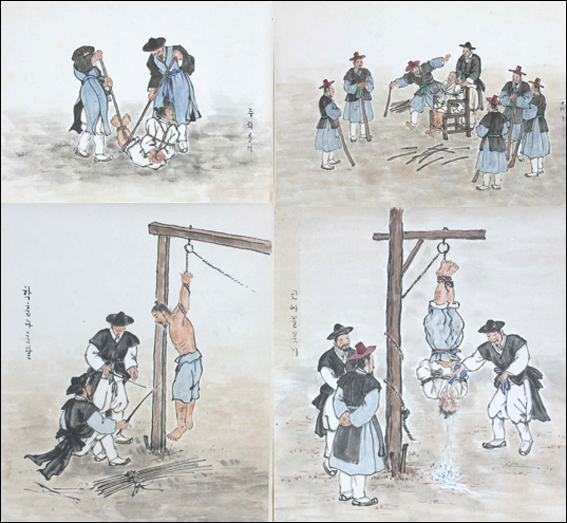

① 주리틀다 : 주리형은 사람의 양다리를 함께 결박하여 그 중간에 2개의 주장을 넣어 가위 벌리듯이 좌우로 벌리게 하는 것으로 일종의 고문방법으로 사용한 것이다. 모반 등의 중대형 사건에서 행해졌고 일반의 경우는 포도청에서 도적을 다스릴 때 사용되었다.
② 난장치다 : 난장은 여러 명이 장으로 신체의 어느 부분도 가리지 않고 난타하는 형벌로서 주로 고문의 일종으로 사용됐으나 자칫 잘못하면 목숨을 잃게 되는 위험한 형벌이다. 이와 비슷한 것으로 주장당문형(朱杖撞問形)이 있었는데 이는 죄수를 가운데 두고 여럿이 죄수의 주위를 돌면서 때리는 형벌이다. 이때 사용하는 장이 붉은 색이었기 때문에 붙여진 이름이다.
③ 학춤과 조달 : 수형자를 발가벗겨서 손을 등뒤로 잡아묶고 팔 안쪽에 막대를 넣어 공중에 매단다. 그리고 등짝을 채찍으로 치는 고문법의 하나.
④ 코에 물붓기 : 도망노비나 죄인을 붙잡아 거꾸로 매달고 콧구멍에 잿물을 붓는 방법으로 정식적인 형벌제도에 따르지 않는 형벌 남용으로 사회문제로 대두되기도 하였다.
① Leg-screw torture. In this, the legs were tied together, the suspect was seated on a chair then two long sticks were inserted between the calves and twisted in opposite directions. This was employed during interrogations into attempted rebellion, or sometimes theft, and in theory it ceased as soon as the suspect confessed. Its use was stricly limited by the legal codes.
② Indiscriminate flogging. Several people armed with clubs strike the accused on any part of the body. sometimes until death ensues.
③ Torture by pouring lye into the nostrils. Certain chronicles claim that such a punishment was sometimes inflicted on slaves or serfs but officially at least it was strictly forbidden.
④ Wipping on the buttocks or the calves of the legs with a cane.